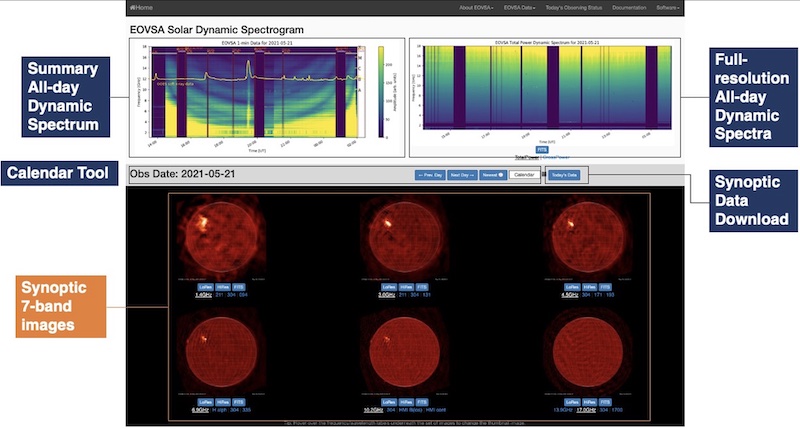Data Access and use EOVSA data
EOVSA Data Products
EOVSA Data Browser: This site provides daily dynamic spectrum (frequency-time diagram) of cross-power amplitude on the shorter baselines and calibrated full-disk images at 7 selected frequencies. One could use this page to check for EOVSA data coverage and download spectra and images processed by our full-disk imaging pipeline. In the near future, we will also provide high time and frequecy resolution spectral image cubes for a list of solar flares processed with our flare pipeline. If you prefer, you can easily browse our existing spectrograms at the RHESSI Browser page and select the "EOVSA Radio Data" checkbox, then use the dropdown menus to enter the desired date. EOVSA data are available starting 2017-Jan-16, with some gaps due to system outages.
Raw "Interim" Database (IDB) Data: The original concept for EOVSA was to record the full-resolution data (1-s time resolution and full frequency resolution) as an "interim" database that would be further reduced in size for different applications (e.g. flares, active regions, full Sun). Then we planned to delete the IDB files due to their relatively large size--too large a data volume to archive. However, given today's storage capacity the files are not actually too large to archive, and therefore these are made available at full resolution (Click the link above.) These are recorded in Miriad format, and hence may not be that useful for most people. Be patient after clicking the link--this is a very long list of directories, one for each available date.
Raw UDB Data: This is the same as for the IDB data, except with 1-minute time integration applied. This is typically not useful for flares, but is perfectly fine for imaging active regions and full Sun. (Click the link at right.) These are also in Miriad format, and hence may not be that useful for most people without our special software for handling that type of data. If you believe that you really need these data, contact us. After clicking the Raw UDB Data link, you will see a short list of directories, one for each year. However, clicking on a year takes you to a very long list of available data, so again be patient while the list loads.
Calibrated CASA Visibility Data: These correspond to the UDB visibility data files but converted to the standard CASA measurement set format with absolute flux and complex gain calibrations applied. As such, they also have one-minute integration applied. This is typically not useful for flares, but is perfectly fine for imaging active regions and full Sun. (Click the link at right.) After clicking the link, you will see a short list of directories, one for each year and month.
To get started using these data, please see our wiki page for the EOVSA Imaging Workshop that we held at NJIT in January 2018. A better set of instructions and tools is being planned.
